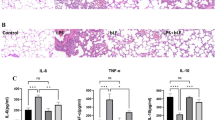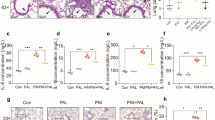Abstract
Our group was the first one reporting that autophagy could be triggered by airborne fine particulate matter (PM) with a mean diameter of less than 2.5 μm (PM2.5) in human lung epithelial A549 cells, which could potentially lead to cell death. In the present study, we further explored the potential interactions between autophagy and apoptosis because it was well documented that PM2.5 could induce apoptosis in A549 cells. Much to our surprise, we found that PM2.5-exposure caused oxidative stress, resulting in activation of multiple cell death pathways in A549 cells, that is, the tumor necrosis factor-alpha (TNF-α)-induced pathway as evidenced by TNF-α secretion and activation of caspase-8 and -3, the intrinsic apoptosis pathway as evidenced by increased expression of pro-apoptotic protein Bax, decreased expression of anti-apoptotic protein Bcl-2, disruption of mitochondrial membrane potential, and activation of caspase-9 and -3, and autophagy as evidenced by an increased number of double-membrane vesicles, accompanied by increases of conversion and punctuation of microtubule-associated proteins light chain 3 (LC3) and expression of Beclin 1. It appears that reactive oxygen species (ROS) function as signaling molecules for all the three pathways because pretreatment with N-acetylcysteine, a scavenger of ROS, almost completely abolished TNF-α secretion and significantly reduced the number of apoptotic and autophagic cells. In another aspect, inhibiting autophagy with 3-methyladenine, a specific autophagy inhibitor, enhanced PM2.5-induced apoptosis and cytotoxicity. Intriguingly, neutralization of TNF-α with an anti-TNF-α special antibody not only abolished activation of caspase-8, but also drastically reduced LC3-II conversion. Thus, the present study has provided novel insights into the mechanism of cytotoxicity and even pathogenesis of diseases associated with PM2.5 exposure.








Similar content being viewed by others
Abbreviations
- 3-MA:
-
3-Methyladenine
- CAT:
-
Catalase
- DCFH-DA:
-
2′,7′-Dichlorofluorescein diacetate
- ECL:
-
Enhanced chemiluminescence
- LC3:
-
Microtubule-associated proteins light chain 3
- MMP:
-
Mitochondrial membrane potential
- NAC:
-
N-Acetylcysteine
- PM:
-
Ambient airborne particulate matter
- PARP:
-
Poly-(ADP-ribose)-polymerase
- ROS:
-
Reactive oxygen species
- SOD:
-
Superoxide dismutase
- TEM:
-
Transmission electron microscopy
- z-VAD-fmk:
-
N-Benzyloxycabonyl-Val-Ala-Asp-fluoromethylketone
References
Donaldson K, Seaton A (2012) A short history of the toxicology of inhaled particles. Part Fibre Toxicol 9:13–25
Pope CA, Burnett RT, Thun MJ, Calle EE, Krewski D et al (2002) Lung cancer, cardiopulmonary mortality, and long-term exposure to fine particulate air pollution. JAMA 287:1132–1141
Ulrich MM, Alink GM, Kumarathasan P, Vincent R, Boere AJF et al (2002) Health effects and time course of particulate matter on the cardiopulmonary system in rats with lung inflammation. J Toxicol Environ Health A 65:1571–1595
Müller B, Seifart C, Barth P (1998) Effect of air pollutants on the pulmonary surfactant system. Eur J Clin Invest 28:762–777
Duarte FV, Teodoro JS, Rolo AP, Palmeira CM (2011) Exposure to dibenzofuran triggers autophagy in lung cells. Toxicol Lett 209:35–42
Thompson CB (1995) Apoptosis in the pathogenesis and treatment of disease. Science 267:1456–1462
Chen M, Wang J (2002) Initiator caspases in apoptosis signaling pathways. Apoptosis 7:313–319
Elmore S (2007) Apoptosis: a review of programmed cell death. Toxicol Pathol 35:495–516
Park SH, Kim JH, Chi GY, Kim GY, Chang YC et al (2012) Induction of apoptosis and autophagy by sodium selenite in A549 human lung carcinoma cells through generation of reactive oxygen species. Toxicol Lett 212:252–261
Soldani C, Scovassi AI (2002) Poly (ADP-ribose) polymerase-1 cleavage during apoptosis: an update. Apoptosis 7:321–328
Dagher Z, Garçon G, Billet S, Gosset P, Ledoux F et al (2006) Activation of different pathways of apoptosis by air pollution particulate matter (PM2.5) in human epithelial lung cells (L132) in culture. Toxicology 225:12–24
Huang Q, Zhang J, Peng S, Tian M, Chen J, et al (2013) Effects of water soluble PM2.5 extracts exposure on human lung epithelial cells (A549): a proteomic study. J Appl Toxicol. doi: 10.1002/jat.2910
Abounit K, Scarabelli TM, McCauley RB (2012) Autophagy in mammalian cells. World J Biol Chem 3:1–6
Baregamian N, Song J, Bailey CE, Papaconstantinou J, Evers BM et al (2009) Tumor necrosis factor-α and apoptosis signal-regulating kinase 1 control reactive oxygen species release, mitochondrial autophagy and c-Jun N-terminal kinase/p38 phosphorylation during necrotizing enterocolitis. Oxid Med Cell Longev 2:297–306
Klionsky D (2013) An overview of autophagy: morphology, mechanism and regulation. Antioxid Redox Signal. doi:10.1089/ars.2013.5371
Jin M, Klionsky DJ (2013) The core molecular machinery of autophagosome formation. Autophagy Cancer 8:25–45
Rubinsztein DC, Gestwicki JE, Murphy LO, Klionsky DJ (2007) Potential therapeutic applications of autophagy. Nat Rev Drug Discov 6:304–312
Levine B, Kroemer G (2008) Autophagy in the pathogenesis of disease. Cell 132:27–42
Deng X, Zhang F, Rui W, Long F, Wang L, Feng Z, Chen D, Ding W (2013) PM2.5-induced oxidative stress triggers autophagy in human lung epithelial A549 cells. Toxicol In Vitro 27(6):1762–1770
Deng XB, Rui W, Zhang F, Ding W (2013) PM2.5 induces Nrf2-mediated defense mechanisms against oxidative stress by activating PIK3/AKT signaling pathway in human lung alveolar epithelial A549 cells. Cell Biol Toxicol 29:143–157
Selvaraj VAM, Cohenford M, Murray E (2012) Arsenic trioxide (As2O3) induces apoptosis and necrosis mediated cell death through mitochondrial membrane potential damage and elevated production of reactive oxygen species in PLHC-1 fish cell line. Chemosphere 90:1201–1209
Gonda MA, Aaronson SA, Ellmore N, Zeve VH, Nagashima K (1976) Ultrastructural studies of surface features of human normal and tumor cells in tissue culture by scanning and transmission electron microscopy. J Natl Cancer Inst 56:245–263
Upadhyay D, Panduri V, Ghio A, Kamp DW (2003) Particulate matter induces alveolar epithelial cell DNA damage and apoptosis: role of free radicals and the mitochondria. Am J Respir Cell Mol Biol 29:180–187
Ding WX (2012) Autophagy in toxicology: defense against xenobiotics. J Drug Metab Toxicol. doi:10.4172/2157-7609.1000e108
Azad MB, Chen Y, Gibson SB (2009) Regulation of autophagy by reactive oxygen species (ROS): implications for cancer progression and treatment. Antioxid Redox Signal 11:777–790
Moore MN (2008) Autophagy as a second level protective process in conferring resistance to environmentally-induced oxidative stress. Autophagy 4:254–256
Zhang J, Ghio A, Chang W, Kamdar O, Rosen G et al (2007) Bim mediates mitochondria-regulated particulate matter-induced apoptosis in alveolar epithelial cells. FEBS Lett 581:4148–4152
Li N, Kim S, Wang M, Froines J, Sioutas C et al (2002) Use of a stratified oxidative stress model to study the biological effects of ambient concentrated and diesel exhaust particulate matter. Inhal Toxicol 14:459–486
Senft AP, Dalton TP, Nebert DW, Genter MB, Puga A et al (2002) Mitochondrial reactive oxygen production is dependent on the aromatic hydrocarbon receptor. Free Radic Bio Med 33:1268–1278
Jung D (2009) Mitochondria as a target of benzo[a]pyrene toxicity in a PAH-adapted and Naïve. Duke University
Le Bras M, Clement M, Pervaiz S, Brenner C (2005) Reactive oxygen species and the mitochondrial signaling pathway of cell death. Histol Histopathol 20:205–219
Van Limbergen J, Stevens C, Nimmo E, Wilson D, Satsangi J (2009) Autophagy: from basic science to clinical application. Mucosal Immunol 2:315–330
Xu Y, Ruan S, Wu X, Chen H, Zheng K et al (2013) Autophagy and apoptosis in tubular cells following unilateral ureteral obstruction are associated with mitochondrial oxidative stress. Int J Mol Med 31:628–636
Eisenberg-Lerner A, Bialik S, Simon H, Kimchi A (2009) Life and death partners: apoptosis, autophagy and the cross-talk between them. Cell Death Differ 16:966–975
Yang Y, Xing D, Zhou F, Chen Q (2010) Mitochondrial autophagy protects against heat shock-induced apoptosis through reducing cytosolic cytochrome c release and downstream caspase-3 activation. Biochem Biophys Res Commun 395:190–195
Maiuri MC, Zalckvar E, Kimchi A, Kroemer G (2007) Self-eating and self-killing: crosstalk between autophagy and apoptosis. Nat Rev Mol Cell Biol 8:741–752
Xu Y, Yu H, Qin H, Kang J, Yu C et al (2012) Inhibition of autophagy enhances cisplatin cytotoxicity through endoplasmic reticulum stress in human cervical cancer cells. Cancer Lett 314:232–243
Acknowledgments
This work was financially supported by grants from Gong-Yi Program of China Ministry of Environmental Protection (No. 200909016), National Natural Science Foundation of China (No. 11275264, 21377127), the National Science and Technology Ministry of China (No. 2007BAC27B02-2), and the CAS/SAFEA International Partnership Program for Creative Research Teams.
Conflict of interest
All authors declare no competing financial interest.
Author information
Authors and Affiliations
Corresponding authors
Rights and permissions
About this article
Cite this article
Deng, X., Zhang, F., Wang, L. et al. Airborne fine particulate matter induces multiple cell death pathways in human lung epithelial cells. Apoptosis 19, 1099–1112 (2014). https://doi.org/10.1007/s10495-014-0980-5
Published:
Issue Date:
DOI: https://doi.org/10.1007/s10495-014-0980-5




